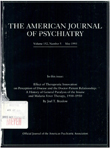Smooth pursuit eye movements and saccadic eye movements in patients with delusional disorder
Abstract
OBJECTIVE: This study used eye movement tests to examine whether frontal lobe dysfunction is present in delusional disorder. METHOD: Smooth pursuit and voluntary saccadic eye movements of 15 delusional patients, 40 schizophrenic patients, and 40 normal subjects were recorded and analyzed statistically. RESULTS: The schizophrenic patients differed significantly from the normal subjects in some smooth pursuit eye movement characteristics, whereas both the schizophrenic and the delusional patients showed more saccades than the normal subjects during the smooth pursuit test. The delusional patients and normal subjects differed significantly in some voluntary saccadic eye movement characteristics. CONCLUSIONS: The data support the idea of a biological dysfunction in eye tracking in delusional disorder.
Access content
To read the fulltext, please use one of the options below to sign in or purchase access.- Personal login
- Institutional Login
- Sign in via OpenAthens
- Register for access
-
Please login/register if you wish to pair your device and check access availability.
Not a subscriber?
PsychiatryOnline subscription options offer access to the DSM-5 library, books, journals, CME, and patient resources. This all-in-one virtual library provides psychiatrists and mental health professionals with key resources for diagnosis, treatment, research, and professional development.
Need more help? PsychiatryOnline Customer Service may be reached by emailing [email protected] or by calling 800-368-5777 (in the U.S.) or 703-907-7322 (outside the U.S.).



